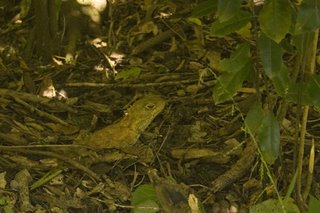18 December 2007
Percussive musings
The concert was recorded and posted online. If you're curious to hear what sort of music I'm playing, go to http://library.music.uaf.edu/ and search for world beat. In this concert we played Agbeko and Kpanlogo, both from West Africa. I especially like Kpanlogo - its really catchy. That crazy cool instrument that you hear is called the gyil. I'm trying to figure out how to get one sent to me from Ghana (and to convince Inari that we have room for one). There are some recordings of pieces from previous concerts as well: I played Bin Tin, Ijexa, Fanga, and maybe Timini. Can't remember very well these days.
The musical choices aren't always my favorite, but its fun to play anyway. I usually prefer something more Latin - rumba, samba, bossanova.
16 November 2007
"If you can..."
They play because its fun and they have fun because they are playing. It's easy to imagine them at their home in Ghana, playing with their family and friends. They probably didn't have much other than music, but that was all that they needed.
They were selling t-shirts and cd's after the show, just like all other musicians. But, they said during the concert that the money that they make of off sales is donated to an orphanage in Ghana. Pretty cool.
They also said that they bring Americans to Ghana for a month in the summer to learn to dance sing, and drum. As they said, "If you can move your legs, you can dance; if you can talk, you can sing; and if you can move your arms, you can drum."
15 November 2007
20th century digital boy
I was really hoping that I'd be able to use skype via a modem, but so far I'm not having any luck. I've read on some forums that it works for some people. We'll keep trying.
06 November 2007
Oregon
Two weekends ago I was in Portland to present my work at the Northwest Glaciology Meeting. It was a pretty good meeting but I didn't get as much feedback as I might have liked. Anyway, I guess meetings aren't about getting feedback, they're about schmoozing. I enjoyed this meeting more than other meetings that I've been to because I feel like I'm starting to know a lot of people in glaciology and have lots of people to catch up with.

Since the meeting was in Portland I was able to stay with friends Jason and Elvira, who had moved there two weeks earlier. Despite their lack of knowledge about Portland, they were great tour guides. We did a little road trip around Mt. Hood and back down the Columbia River Gorge. Its a pretty area - reminds me a bit of parts of New Zealand. And the trees are so big! Well, at least compared to the tiny black spruce outside our cabin.

11 October 2007
Best of Greenland, 2 of 3
Well, I have managed to do a few things other than work and reading. I've joined an intramural soccer team, which has been really fun. I haven't played soccer for many, many years, and I usually end up going home sore. The first week I had a bruise on top of my collarbone (I got elbowed while going for a header) and this week the back of my knee has been sore. I didn't realize that soccer is such a tough sport. Or maybe I'm just starting to show the first (?) signs of old age. Anyway, its been really fun and I'm inspired to play more.
---------
Now back to my Best of Greenland series. I didn't manage to get my photos submitted for the show, so I'll have to wait until next time around.
Here is a photo of water-filled crevasses on Ilulissat Glacier (aka Jakobshavn Isbrae). I really like the color. Unfortunately the image isn't sharp enough to print it really big - I tried and wasn't happy with the results.

21 September 2007
Best of Greenland, 1 of 3
Here is the first one - a little cliché, perhaps, but I like it anyway.

I really like that the Greenlanders still use the more traditional qajaqs (spelled differently in Greenland than in Alaska). Hunting is done primarily from boats (and with dog sleds in winter). These qajaqs seem to be used primarily for recreation.
P.S. Eemeli, thanks for encouraging me to get a circular polarizer. It really can make a boring sky look nice, as in this photo.
09 September 2007
World News Tonight
http://abcnews.go.com/Video/playerIndex?id=3573900
http://abcnews.go.com/Video/playerIndex?id=3573668
06 September 2007
Media circus
In the three weeks that I was in Ilulissat I talked with 6 different reporters and gave a tour to Angela Merkel, the chancellor of Germany and supposedly the most powerful woman in the world, and to Anders Fogh Rasmussen, the prime minister of Denmark.
The reporters were from around the world - ABC News, Aftonbladet (Stockholm's evening news), Tokyo Broadcasting Station, NHK (Japanese), Haaretz (Israeli), and MSNBC. I missed an interview with a Norwegian reporter because of troubles with our flights, and I've also been contacted by the Oregonian. This is really insane. At first it was quite exciting to know that my work was receiving so much attention, but now I just roll my eyes when I hear that a reporter wants to talk to me. But then again, I am funded by public money and think that the public should have access to our research findings, so I cooperate as best I can.
I've already made an appearance in the Aftonbladet; the article is in Swedish, but there is a close-up of yours truly. In the article I'm compared to Professor Calculus from the Adventures of Tintin. That didn't mean anything to me, but Inari found it pretty funny.
I'll let you know when I make any appearances elsewhere.
I couldn't find any photos of me with the chancellor, but I did find this, which basically says that I will be giving a tour to Angela Merkel. I had dinner with the dignitaries - it was an informal dinner, which meant that you didn't have to wear a tie. I ended up borrowing a suit from somebody that works at the German embassy in Denmark. The next day we flew out to our campsite and I talked with the dignitaries for about 15 minutes, explaining what we are doing and why its important. Her critics claimed that she went to Greenland just as a publicity stunt, and I think they are probably right. She said that she wanted to meet with scientists - she met with two of us for a total of about 30 minutes - and I was picked because I was the only scientist in town at the time. On the other hand, a good photograph makes for a strong political statement.
14 August 2007
Getting educated

Last Thursday was the first day of kindergarten in Ilulissat. Here, the children start their school career by wearng traditional Greenlandic clothing. They're traditional in the sense that their origins are very old but, as you can see in the pictures, the clothing has evolved considerably through the years. At noon the children and parents gathered outside the school, and one by one they were introduced and welcomed to the school and given a Greenlandic flag. The proud fathers documented the event with the cameras, just like they do everywhere else in the world. I thought it was a very nice tradition and I was happy to witness it. Most of the kids were very shy, but a few had big grins on their faces.

From what I've heard, the education system in Greenland is very poor. They are just now in the process of developing their first university. Many towns don't have high schools - the towns are just too small. Even the kids in Ilulissat, the third largest "city", have to go to boarding school in the town of Aassiat once they turn sixteen. The poor education system is a big reason that I'm here right now. In addition to my research, I'm spending about two weeks working with the municipality's "science interpreter". I've been told that even though there are many scientists coming to Ilulissat, the local people don't gain anything from the visits, and in fact they are often the last ones to find out about the research results - when they are discussed on the BBC. So we are trying to bring our science to the community and especially to the children. We want to teach them science as well as the scientific process. I'm working on a poster that will be displayed at the schools and in the town museum. We've also organized a public meeting with myself and a couple of other scientists. And, just yesterday I learned that I will be giving a presentation at the local school - a chance for the kids to practice their English and to learn about the interesting glacier in their backyard. I just wonder who will learn more - the kids or myself
06 August 2007
A bridge, nostalgia, a wedding
On my way to Greenland I made a short visit to
I was passing though
The wedding was fun- it was especially nice to catch up with old friends, though I would’ve like to talk more with Sing-Wei.
23 July 2007
My 15 minutes
Update: The clip was aired on 1 August 2007, and can be found online.
06 July 2007
Mt. Prindle, a Carhartt wedding, and canoeing
 Two weekends ago I went rock climbing at Mt. Prindle with friends Laura and Pierre. We left Fairbanks Friday evening and drove north on the Steese Highway for about two hours. We then turned onto a logging road and continued on, fording two streams in the process. It was quite clear that the car couldn't make it past the third stream, so we took our bikes off the roof of the car and rode a few miles to the end of the road. From there it's a 7 mile hike up and over a couple of hills to the base of the climb. We ended up hiking until 1 am (in full sunlight!) . Saturday we woke up late in the morning, discovered that we didn't have a pot (my bad), ate cold oatmeal (yumm...) and continued on to Mt. Prindle. We relaxed in the sun with the mosquitoes on Saturday evening, climbed Sunday morning, and were back in Fairbanks by midnight on Sunday evening.
Two weekends ago I went rock climbing at Mt. Prindle with friends Laura and Pierre. We left Fairbanks Friday evening and drove north on the Steese Highway for about two hours. We then turned onto a logging road and continued on, fording two streams in the process. It was quite clear that the car couldn't make it past the third stream, so we took our bikes off the roof of the car and rode a few miles to the end of the road. From there it's a 7 mile hike up and over a couple of hills to the base of the climb. We ended up hiking until 1 am (in full sunlight!) . Saturday we woke up late in the morning, discovered that we didn't have a pot (my bad), ate cold oatmeal (yumm...) and continued on to Mt. Prindle. We relaxed in the sun with the mosquitoes on Saturday evening, climbed Sunday morning, and were back in Fairbanks by midnight on Sunday evening. Mt. Prindle has some impressive rock outcrops, the highest of which is over 300 m high. Unfortunately most of the rock is completely covered with lichen, so the climbing isn't as nice as it looks from afar. Anyway, it was fun to do a long climb - something that you can't do in many places around Fairbanks. I've only done a couple of multi-pitch climbs before. It takes some getting used to. I was a little nervous at first, but once I started focusing on climbing (and not looking down) everything was fine. Pierre is a very good climber and did all of the leading, so there really wasn't much for me to worry about. I'm just glad that he led and not me!
Mt. Prindle has some impressive rock outcrops, the highest of which is over 300 m high. Unfortunately most of the rock is completely covered with lichen, so the climbing isn't as nice as it looks from afar. Anyway, it was fun to do a long climb - something that you can't do in many places around Fairbanks. I've only done a couple of multi-pitch climbs before. It takes some getting used to. I was a little nervous at first, but once I started focusing on climbing (and not looking down) everything was fine. Pierre is a very good climber and did all of the leading, so there really wasn't much for me to worry about. I'm just glad that he led and not me!This past Saturday Inari and I attended our friend's wedding. It was truly a Fairbanks wedding - the guests were asked to wear Carhartt's and bring some food to share. It was complete with piñatas and a group of about 30 youngish people (mostly geology graduate students) dancing in the rain. These dancers included the bride, who was wearing hiking boots under her traditional wedding dress. A lot of old friends were in town - it was good to see everybody.
On Sunday I went on a short canoe trip on the Chatanika River, and then remembered how much I enjoy canoeing. I then proceeded to buy a roof rack for our car, 2 nice life jackets for paddling, and a paddle for Inari. We went again on July 4th. I'm hoping to squeeze in some more paddling trips this summer, but there isn't a lot of time left! I'm going fishing this weekend, and Inari's sister Anu is coming in a few weeks... After that I'm off to Greenland again and won't be back until early September. Phew!
22 June 2007
What is productivity?
This past field season was a struggle and so it was quite a humbling experience. Last year everything went really well, so I kind of expected more of the same... The instruments that we left running over winter failed, and nearly every instrument that we brought with didn’t work as it was supposed to — at least not at first. This included a wind gauge, a precipitation gauge, a marine radar (for tracking iceberg motion), an automatic theodolite (for optical surveying), several GPS, and an ablation meter (measures ice melt rates). On top of that we had some pretty bad luck with weather during the first two weeks at our camp. The first night that we were there we had 60+ knot winds. Martin lost his tent in the wind and broke his glasses when they were blown off his face. All of the tents suffered some damage. A week later we got hit by another storm. You could hardly stand up outside, let alone try to do something productive. This was also probably the first time that I’ve ever slept with ear plugs. It was really something. I’m sure I’ll remember it fondly some day. Check out this poor tent:

In the end we managed to accomplish most of what we had set out to do. At any rate, it gave me a new perspective on how difficult field work can actually be. I was certainly feeling pessimistic about our work for a couple of weeks.
During the last two weeks — we were out for a month — the weather cleared up. Actually, it was amazingly beautiful weather. It was actually hot, and there was very little wind. That’s quite unusual, because large glaciers often have strong winds blowing down-glacier. We had a lot of time to relax during those two weeks. I passed my time by reading Finnish children’s stories and cleaning up all the dirt. Its really a dirty place.
We also played network video games (not really),
ate narwhal,
and formed a band (photo for the c.d. cover).
19 June 2007
Return to summer
I've started keeping a journal while doing field work because after a while the days blur together. I'll try to type up some of my entries and post them here. Maybe they're interesting?
For now, I'll leave you with a link to a video that I put together. About once a week we witnessed a BACE (bad ass calving event), during which a large part of the glacier tongue would break off and roll around in the fjord, making a lot of noise in the process. The icebergs are huge- the ice cliff that you'll see in the video is 80-100 m high, meaning that the ice is on the order of 800 m thick. Try picturing that rolling around in your neighborhood! This particular calving events lasted for about 20 minutes; I took one frame every 10 seconds and compressed the whole sequence into about 20 seconds.
For an avi file, click here. For a wmv file, click here. Sorry if they don't work on your machine.
01 May 2007
Squirrel fever
Inari falls into the second category. She made a bird feeder that just happens to have a large enough opening to double as a squirrel feeder. I do think squirrels are pretty cute, but I'm not convinced that intentionally attracting them to your house is a good idea. Well... Sometimes you don't always have a say in these things. So I just accept it and use it as an opportunity to play with my telephoto lens.

27 April 2007
Into summer
A while back Martin and Dana had asked her to make a painting for their daughter's room. She struggled with it for several months and finally finished it, but mostly because she just wanted to move on. Inari told Dana at the opening that that piece was intended for them, but if they didn't like it then they could choose another one. Dana didn't relay the message to Martin. After seeing the exhibition today Martin told me that he was really disappointed that the piece that he liked most was listed as "Not for sale". Guess what piece that was?
So that's what Inari has been up to. I've been frantically getting equipment ready for our upcoming field season. I can't believe that I'm already leaving next Friday. I'm really looking forward to getting away from my computer and out into the sunshine. We've had some amazingly beautiful weather for the last month but I've hardly had the chance to enjoy it.
Our research project is getting more and more exciting all the time, too, largely because of the big changes that are occurring on the Greenland Ice Sheet. This year we'll have a Greenlandic reporter out at our field site filming us and interviewing us for a Greenlandic television show, and we've been contacted by reporters from several major news agencies, including PBS and the BBC. Also, a photographer for National Geographic will be out there running time-lapse cameras at the glacier terminus.
26 March 2007
inari.com
Going solo (skiing)
Last Wednesday I flew by small aircraft to Manley Hot Springs, an end-of-the-road village that is about 80 miles west of Fairbanks as the crow flies. From there my goal was to ski back to my cabin in Fairbanks. After arriving in Manley I put on my skis and threw my 60 lb (27 kg) pack on my back and started shuffling down the street. That first day I navigated my way through a maze of snowmachine trails partly by luck and partly by instinct. These trails are definitely for people that live there and know the land well. The first day was almost without incident, except that near the end of the day I missed a turn that I was supposed to make and ended up at an old sourdough's cabin. He invited me for a cup of coffee (I declined), told me a little bit about the trail that I was supposed to be on (the trail used during the Serum Run, a fascinating story for those of you that don't know it), and pointed me in the right direction. I felt pretty good about my first day - I had covered over 25 miles (40 km) and was well on my way home.
That night it snowed, just a little, but it was the bad kind of snow: granular, coarse snow that grips your skis and makes you wonder why have these heavy things strapped to your feet. The trip became a death march. My hamstrings quickly tightened up, which was followed by sore feet and a swollen achilles (tendonitis, I believe). I passed through the Dugan Hills and Deadman Lake - didn't stay there too long! Then onward pass the settlement at Tolovana and into the aptly named Minto Flats. Day two had me second guessing my ability to make it home. Would I have to turn around? Should I take a trail to a different village and hitchhike home?
Friday morning wasn't much better, slow and frustrating. The trails got better as I approached Old Minto, a former native village and now a drug and alcohol abuse center. I began to regain my confidence. Its amazing how many mood swings I went through on that trip. I thought I could make it all the way to Fairbanks, it might hurt a little, but that's okay. And at that moment the buckle on my hip strap snapped, meaning that all of those 60 lbs of gear and food would be resting on my shoulders for the last 50 miles. Ouch. I still could have turned towards Nenana (rhymes with banana) and shortened my trip, but I decided to continue on.
Friday night it snowed. Again, more bad snow. I wound my way through a labyrinth of rivers, ponds, and swamps and finally hit the Alaska Railroad. That was a comforting thought, now I was in a safe area and starting to get close to Fairbanks. The trails should also improve, or so I thought. The terrain became more familiar, I recognized some hills in the distance. But still the skiing was slow. I skied 11 hours on Saturday, but still covered less ground than I had covered in 8 hours on Wednesday. Furthermore, that night I discovered that part of the pain in my right foot was due to a huge blister that now makes walking quite difficult. I'm pretty sure the blister was a result of skiing with frozen boots in the morning. They had thawed out by afternoon and became more flexible.
I hadn't given up hope of making it home, but I began to seriously consider alternative routes. I had plenty of food - way too much in fact - so time wasn't too much of an issue. Weather ended up being the determining factor. That evening it dropped below -20 F (-30 C) and I could hardly sleep. I woke up several times shivering and was eventually unable to fall back asleep. I decided that there was no point in lying in my sleeping bag shivering, so I got up at 3:30 and took the shortest possible route to the highway. I would hitchhike home after all. The night sky was clear, the moon was bright, and I was treated to a spectacular auroral display that lasted for at least 2 hours. I enjoyed it thoroughly, and took it as a sign that I had made it.
I had no trouble getting a ride home. Its pretty easy when its cold and you look beat up. I made it home in time to go out for a big breakfast at Sourdough Sam's, a rewarding finish to a tough trip.
So, why did I do this trip? I'm not sure. But I'm sure it won't be my last ski trip. Going solo was a very different experience, I felt more aware, but also more insignificant. I had no support, mentally or otherwise. I tested my limits and came away with nothing more than some wounds that will heal in a few days. I learned something about the land where I live, where people have lived (amazingly) for thousands of years. I gained more respect for pioneers, building trails and living on the land. And I learned that as I much as I love wilderness, I still need some modern comforts. I ultimately didn't achieve my goal, but I did put myself into a position that I could have achieved it if it was really that important to me. And I didn't lose any toes.
23 February 2007
Mary Shield's Cabin, Part II
Two weekends ago I found myself skiing out to Mary Shields’ cabin with Martin and Dana and their 2 year old daughter Sonja, and Keith (another glaciology professor). This was the second time that I’ve made the trip (see February 2006). It was a lot of fun and mostly uneventful, except for one near disaster… On the way into the cabin on Saturday we encountered a long stretch of overflow that had not yet frozen. (Overflow occurs when a creek freezes to the bed, but there is still water being fed into the creek. The water pressure gets too high, and it squirts to the surface through cracks in the ice, the result being that there is water everywhere.) We managed to get through the overflow with little difficulty – just wet feet, but that wasn’t a major problem because it was quite warm.
21 February 2007
Yukon Quest
 Mackey eventually arrived and we were all happy that we could go back to our cars to warm up. The dogs looked happy and eager to continue on, even though they had just run 1000 miles in 10 days, and in doing so broke the old course record by over 12 hours. Mackey is also planning to run in the Iditarod, another 1000 mile long race; it starts in two weeks
Mackey eventually arrived and we were all happy that we could go back to our cars to warm up. The dogs looked happy and eager to continue on, even though they had just run 1000 miles in 10 days, and in doing so broke the old course record by over 12 hours. Mackey is also planning to run in the Iditarod, another 1000 mile long race; it starts in two weeks
19 February 2007
Rainbow Peak

19 January 2007
Tolovana Hot Springs

The weekend after New Year's we headed out on another cabin trip, but this one involved a sauna and colder temperatures. Most people left on Friday and came back on Sunday. I wasn't feeling too good on Thursday, so I decided not to go. (Admittedly, I wasn't all that excited about skiing 11 miles at -20 to -30 F (-30 to -35 C).) I felt better all day Friday, and I wasn't too happy about people having fun without me, so I packed up my things and got ready to head out on Saturday. I got an early start, started skiing at 10:00 am (before the sunrise) and made it into the cabin by 1:00 pm, just as they were finishing breakfast/brunch/lunch - it was a lazy morning for them.
The "group" consisted of 1 snowmobiler ("snowmachiner" in the Alaskan dialect), 4 skiiers (1 on tele-skis, 1 on randonee, and 2 on cross-country), 4 snowshoers, and 4 walkers/sledders, and 2 dogs. I'm usually not too keen on having snowmobiles around, but in this case it was a good thing. It was nice to have the security of knowing that if somebody got dangerously cold skiing/snowshoeing/hiking, that we could get them to the cabin quite quickly. We also got to bring with some things that you wouldn't bring without a snowmobile, like milk, juice, and a keg of beer.
Saturday afternoon was spent chatting and eating, in the evening we went for a dip in the hot springs. All 13 of us.
We got up relatively early Sunday morning and headed back to the trailhead - staggering everybody's start time so that we would all finish the journey at about the same time. We arrived in the early afternoon and started up the cars - or tried to. Three of them started no problem, one needed to be jumped and heated up with camping stove, and the fifth car just wouldn't start. We left it there and returned the next day with a generator and heater and a new battery - that did the trick.

Self-portrait after skiing 11 miles in frigid temperatures.
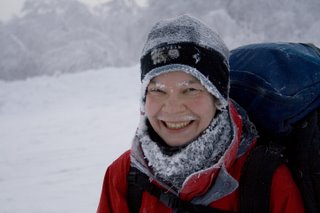
Inari after snowshoeing 11 miles.
It turned out that Saturday was the nicest day of the weekend, and so I felt glad that I chose to wait until then to ski in. The light was beautiful and there was no wind, a rare thing on that trail. It took me three hours to ski to the cabin, but it probably would've been quicker if I hadn't stopped to take so many photos.

Dr. Seuss's inspiration?

Spectacular light on Saturday morning.
New Year's Eve

Here's the New Year's group, from left to right: myself, Siren, Inari, Mica, Sandy, Safira, Tico, Anja, Bailey, Eamon, Elvis, and Scout.

The mulled wine, a German tradition. You pour wine into a pot, put a sugar cone over the top, pour rum over it, light it on fire, and add more rum.
16 January 2007
Brian and Lynley
One of the researchers that I worked with is an interesting character and deserves a post of his own. Brian has a Ph.D. in glaciology and now works half-time doing glaciology research. The other half of his time he spends being a good citizen: protesting, writing letters to the newspaper, and taking mining companies to court. At the moment he is working on a campaign to prevent a mining company from working in an area (the only area) where an endangered species of snail lives. The mining company wants to simply relocate the snails, but then, why do the snails only live in this one area? Maybe the snails wouldn't be too happy about being relocated.
Brian and his partner Lynley were living in a bus for several years (they're now working on a building a house), the bath is outside and is heated by fire, and their outhouse consists of a hole in the ground - no roof or seat! Brian built a small hydropower system out of an old washing machine and protected from the elements by covering it with a real estate sign. He also built a wind turbine, but that fell down during the first storm. The car runs on veggie oil, which he picks up from various hotels and restaurants in town. I got to go with him to pick up a load (1000 L) of veggie oil. See photo below - containers of veggie oil pictured with the bus.

Here's a view of the shed where Brian processes the veggie oil before using it in his car. He's still trying to figure out to do with the all of the crud that he's filtered out. He said that he's leaning towards building a flame thrower (why?!?) but that he might also give it to the fat man who ships it to China to be made into lipstick...

It was a little bit funny being in the field with him and Tom (master's student). Tom works at a gear shop and has very fancy clothing and equipment; Brian uses gear that might be older than I am.
New Zealand plant life

The aptly named "vegetable sheep".

Poroporo, a plant traditionally used by the Maori for medicinal purposes. The berries are poisonous until they become ripe. (In Finnish, poroporo would mean "reindeer reindeer".)

New Zealand Edelweiss - just a little bit different than the real thing.

The flower of kotukutuka (tree fuchsia), one of the only native deciduous trees in New Zealand.

New Zealand flax...

and a flax flower, which grows on a stem that is much longer than the rest of the leaves.
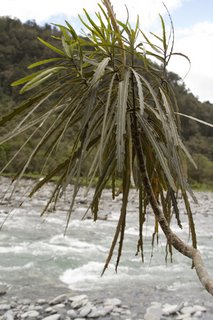
Lancewood (I'm having trouble finding the Maori name), a plant that looks different during its juvenile stage than during its adult stage. During the juvenile stage, the sharp leaves point upwards; as the tree gets taller the leaves start to point downward and become fleshier. It is thought that this was to discourage browsing by moa. When the plant is short, its leaves are to sharp for a bird to eat, and when the plant becomes taller to it is too high off the ground for the moa to reach.

Very few native plants in New Zealand are edible; this is one of them. The leaves are very spicy and would probably be nice on a salad or soup, but apparently nobody uses them.
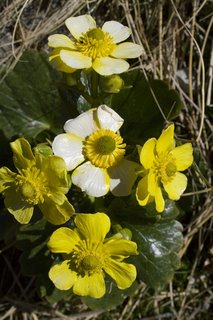
The Mt. Cook Lily, high alpine flower found on the south island..
02 January 2007
The friendly birds
Unfortunately, the Maori and later the Europeans killed off much of the native bird life through hunting, habitat destruction, and the introduction of exotic species. Some interesting birds have managed to survive, such as the endangered kiwi, the kea (a mountain parrot), the weka, and the tui and the bellbird or korimako.
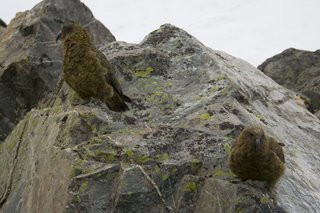

I didn't manage to see any kiwi, but we were visited by two kea at our hut, and I saw several weka begging for food at tourist sites. The kea were really cheeky and fun to watch. The clearly weren't concerned by our presence - they were more concerned about trying to rip the roof off the hut.
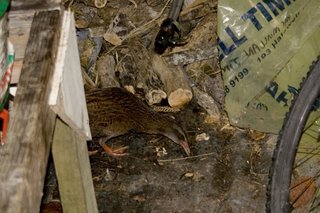
This weka I spotted searching for food in a little shed.
I also saw and heard several tui and bellbirds, but they are quite small and difficult to photograph. They are songbirds in the truest sense of the word, and hearing them greet the morning sun is a real pleasure. The tui are especially fun because they have two voice boxes and can therefore produce a wide range of sounds (some that humans are unable to register) and have they ability to mimic other sounds, such as bellbirds.
Tasman Glacier and De la Beche Hut: Home for a Fortnight

Our field site was Tasman Glacier, which is New Zealand's longest glacier with a total length of 25 km. Its upper accumulation area has an elevation of over 3000 m and is thought to receive something like 12 m of precipitation a year. The glacier is within Aoraki/Mt. Cook National Park and is popular tourist destination for climbers, especially those wishing to climb Aoraki, the highest peak in Australasia. I prefer the Maori name "Aoraki" because it was the first name given to peak and it is a beatiful and appropriate name - meaning "cloud piercer". We had a nice view of the summit of Aoraki from our hut and often observed it piercing the clouds.
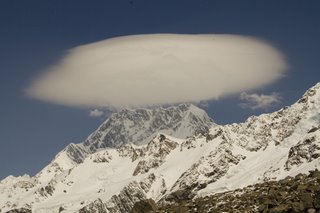
Only rarely does field work involve staying in a hut, and it was a real treat, especially during periods of rainy, windy weather. The huts in Aoraki/Mt. Cook National Park are all equipped with radios, and this allowed us to get weather reports and to arrange for a helicopter to pick us up when we finished our work.
Here's a view of the inside of the hut.

The field work was greatly complicated by the fact that the Tasman Glacier has thinned significantly over the past 100 years. The hut is now located some 100 m above the glacier, and the only way to access it is to scramble up a steep, unstable moraine. It wasn't quite steep enough to require the use of a rope, but if you picked the wrong route (as I did on two occasions) you would find yourself wishing that you had one. The photo below shows the moraine that we could to scramble up and down everyday, sometimes carrying heavy equipment, food, or our toilet.
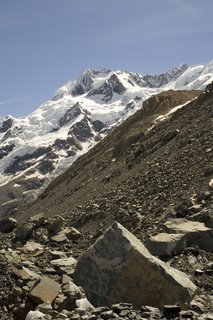
Wellington

In total I spent about one week in Wellington, the capital city of New Zealand. In the last few years I've spent a lot of time in the wilderness on hiking trips and during field work, and so trips to cities are becoming more and more novel. I really enjoyed my time in Wellington, probably in part because the weather was really nice while I was there. The city reminds me of San Francisco, though smaller and less diverse. It has a large natural harbor, sits on a major fault and is sure to be decimated by a major earthquake at some point in the not-too-distant future, has a small island where they used to put inmates, has steep windy roads, lots of old wood houses, numerous cafes, and it has a climate similar to San Francisco. Both Wellington and San Francisco were built in a haphazard way - San Francisco by miners, Wellington by a city planner living in England who didn't consider topography in his design.

The view from Tom's apartment.
Wellington has many "secret staircases" that cut up and down the hills that make great shortcuts, as long as you know where you are going. Many houses don't have direct access to the road - some have little trams that you take you from the road to the house, others just have very long staircases. My favorite thing about Wellington was that it was very urban yet also very peaceful. In about 15 minutes you can walk from the city center to a heavily vegetated suburb. The houses sit close to each other, but you hardly notice your neighbors. The area is so lush that I got the impression that if you left town for a couple of months you might need a machete in order to "reclaim" your house.
The last day that I was in Wellington I went to the Karori Wildlife Sanctuary with the hope of spotting a tuatara, a very special reptile that has remained relatively unchanged over the past 200 million years. The tuatara, which is endangered, was once found throughout New Zealand but now only lives on remote islands with few predators. It has recently been brought to Karori Wildlife Sanctuary in an attempt to reintroduce it to the north island. I've been told that they reproduction rates are very low and that they grow slowly, making reintroduction a difficult task. However, they can live to be 100 years old. Check out the description of tuatara on wikipedia - they are really fascinating creatures.
Anyway, I got lucky and I was able to snap a few photos of a tuatara.
